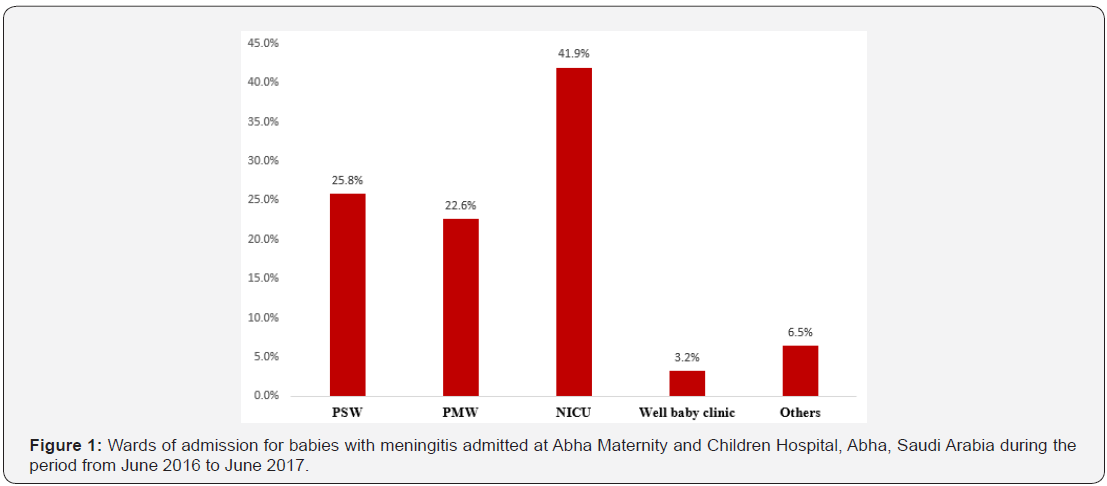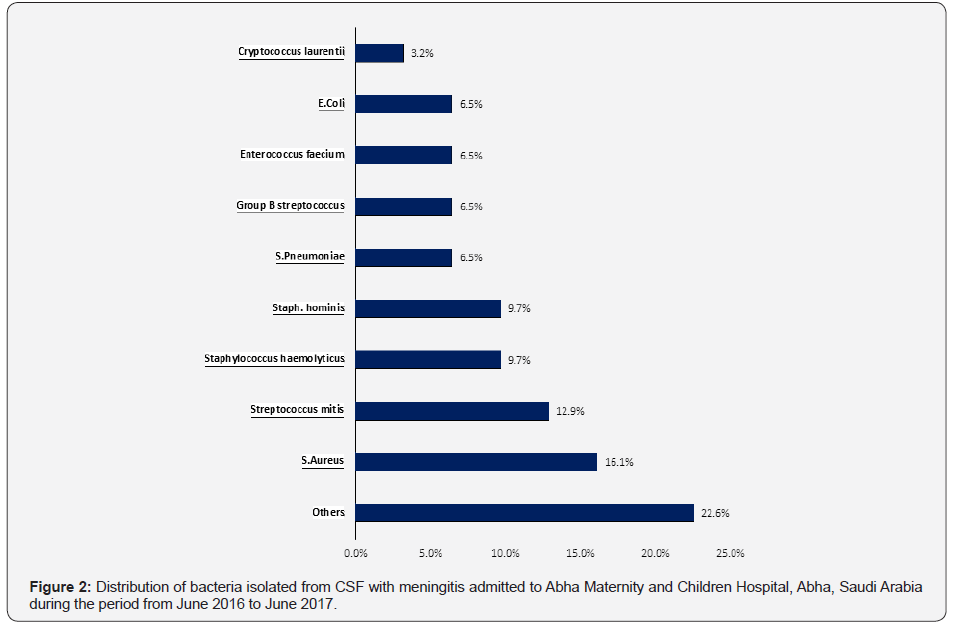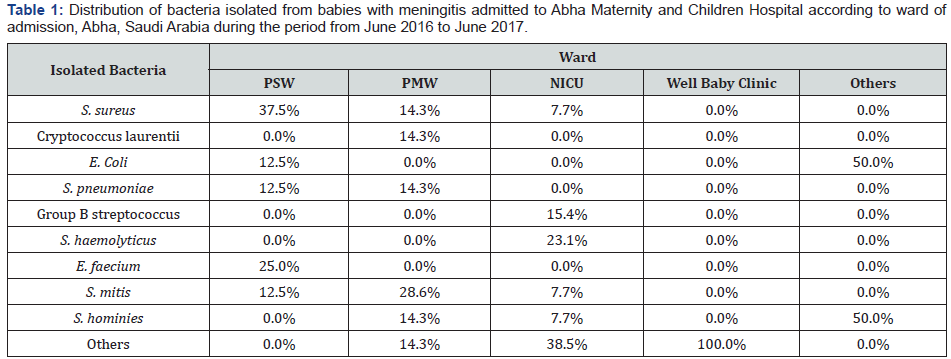Juniper Publishers : The Most Common Causative Organisms Causing Meningitis in Abha Maternity and Children Hospital, Abha, Saudi Arabia
JUNIPER PUBLISHERS- JOURNAL OF GYNECOLOGY AND WOMEN’S HEALTH
Journal of Gynecology and Women’s Health-Juniper Publishers
Authored by Mohammed Almaghrabi*
Abstract
Background:Pediatric bacterial meningitis is a life-threatening illness that results from bacterial infection of the meninges.
Aim:To identify the most common causative bacteria of meningitis among children admitted at the study setting in maternity and children hospital, Abha city.
Methodology:A recorded based retrospective case series study design was used to collect data of all suspected cases of meningitis who were admitted to Abha Maternity and Children Hospital during the period from June 2016 to June 2017.
Result:StaphylococcuS aureus was the most commonly isolated bacteria (16.1%) followed by Streptococcus mitis (12.9%), Staphylococcus haemolyticus and Staphylococcus hominies (9.7% for each), and Staphylococcus pneumonia (6.5%).
Conclusions & Recommendations:The current study revealed that there the dominant bacterial species causing meningitis were Staphylococci and Streptococci. There was a lot of species variety in the isolated bacteria causing meningitis especially in different departments.
Keywords: Meningitis; Bacteria; Bacterial meningitis; Infant meningitis; Meningitis causative agents; Meningitis epidemiology; Meningitis outcome in infants
Abbrevations: CSF: Cerebrospinal Fluid, NICU: Neonatal Intensive Care Unit, PSW: Pediatric Surgical Word, PMW: Pediatric Medical Word
Introduction
Meningitis is the medical term for inflammation of the tissues (meninges) that surround the brain and spinal cord. The inflammation is most commonly caused by a virus or a bacterium, which travels from an infection in another part of the body through the bloodstream to the meninges [1-2].
Pediatric bacterial meningitis is a life-threatening illness that results from bacterial infection of the meninges [3]. Bacterial meningitis in the neonatal period has its own unique epidemiologic and etiologic features [4,5]. Beyond the neonatal period, the 3 most common organisms that cause acute bacterial meningitis are Streptococcus pneumoniae, Neisseria meningitidis, and Haemophilus influenzae type b (Hib). Since the routine use of Hib, conjugate pneumococcal, and conjugate meningococcal vaccines in the United States, the incidence of meningitis has dramatically decreased [6,7].
However, morbidity among survivors remains high. Types and distribution of pathogens are related to gestational age, postnatal age, and geographic region. Confirming the diagnosis is difficult. Clinical signs are often subtle, lumbar punctures are frequently deferred, and cerebrospinal fluid (CSF) cultures can be compromised by prior antibiotic exposure. Infants with bacterial meningitis can have negative blood cultures and normal CSF parameters. Promising tests such as polymerase chain reaction (PCR) require further study. Prompt treatment with antibiotics is essential. Clinical trials examining a vaccine to prevent neonatal Group B Streptococcus infections are still ongoing [7-10].
The current research aims to identify the most common causative bacteria of meningitis among children admitted to Abha Maternity and Children Hospital during the period from June 2016 to June 2017.
Method
A retrospective case series study was designed. All collected data were suspected cases of meningitis for 30 admitted patients at Abha Maternity and Children Hospital during the period June 2016 to June 2017. The age of children involved in this study ranged from 1 month to 4 years. Accessible data including ward of admission and isolated bacteria from CSF culture were included in this study. All requirements for data collection including ethical and administrative approvals were taken before data collection.

Collected data were analyzed statistically using software IBM SPSS version 22. The given graphs were constructed using Microsoft excel software. All statistical analysis was done using two tailed tests and alpha error of 0.05. Descriptive statistics was done mainly by stating frequencies and percentages of both wards of admission and isolated bacteria. Moreover, the relationship between ward of admission and the most frequently isolated organisms was undertaken.
Result
Most of the meningitis cases were observed in NICU (41.9%), whereas, only 3.2% of observed cases were attributed to wellbaby clinics. The percentage of observed cases of meningitis in pediatric surgery and medical wards were 25.8% and 22.6%, respectively (Figure 1). We found that StaphylococcuS aureus is the most dominant pathogen causing pediatric meningitis (16.1%) followed by Streptococcus mitis (12.9%). Surprisingly, Streptococcus pneumonia recorded a percentage of only 6.5 as well as Enterococcus faecium and group B streptococci. It is been observed that 9.7% of isolated bacteria from babies was characterised as Staphylococcus haemolyticus and Staphylococcus hominis. There were also 22.6% of other types of bacteria which were sporadically isolated (Figure 2).


Table1 showed that most of pediatric meningitis cases which were investigated in PSW caused by S. aureus (37.5) and E. faecium (25%). On the other hand, S.s mitis was dominant pathogen causing meningitis in PMW with a percentage of 28.6%. Approximately one quarter of NICU meningitis was caused by S. haemolyticus.
Discussion
Bacterial meningitis is currently a major problem which is considered a life-threatening illness. Although, most of meningococcal infections are caused by S. pneumoniae, N. meningitidis, and H. influenzae type b (Hib), new studies revealed that some more bacteria can be very often identified as causative agent for meningitis [3,6].
In this study, data were collected and analyzed for 30 patients during the period from June 2016 to June 2017. All selected patients were admitted children (1-4 years old) to Abha Maternity and Children Hospital, Kingdom of Saudi Arabia. Accessible data also included ward of admission and isolated bacteria from CSF culture.
The study has shown that 41.9% of the included children were admitted to NICU department as most of the included children were below 1 year with low and immature immune system and also there were high prevalence of chest infections and pneumonia rates. The second most common wards of admission were PSW and PMW (25.8% and 22.6%, respectively). There was only one child was taken from the well-baby clinic. This might indicate that NICU need more restricted procedure to eliminate the incidence of meningitis among admitted children.
Surprisingly, it is been found that the most common isolated bacteria causing meningitis are S. aureus and S. mitis, followed by S. haemolyticus and Staphylococcus hominies (9.7% for each). Minority of meningitis cases were caused by S. pneumonia, E. Coli, group B Streptococci and E. faecium.
Finally, this study has shown that the dominant bacteria causing meningitis in NICU ward were S. haemolyticus (23.1%) and Group B Streptococci (15.4%), whereas, S. aureus was isolated from only 7.7% of the included cases. Considering PSW, the most commonly isolated bacteria were S. aureus (37.5%), E. faecium (25%), E. Coli (12.5%), S. pneumoniae (12.5%) and Streptococcus mitis (12.5%). In PMW, S. mitis was isolated from 28.6% of admitted children. While S aureus, C. laurentii, S. pneumoniae, and S. Hominies were found to cause meningitis in a percentage of 14.3% form involved cases for each. About half of the children who were admitted to other departments had Staph. hominies as the major isolated bacteria causing meningitis. The variety at the isolated bacteria according to the department based mainly on the nature and environment of the ward and also the compliance to infection control guidelines which may be more adherent at NICU and PICU than general wards.
Conclusion and Recommendation
The current study revealed that there were high variety at the isolated bacteria causing meningitis among the included children especially in the different departments. Also, normal flora (staphylococci and Streptococci) were of high role in causing meningitis specially at NICU due to low immunity of the admitted neonates. Researchers recommend that, more supervision is needed for the medical staff specially those who work at the high risk places (NICU and PICU) is needed to adhere to the infection control guidelines and this should be accompanied with health education sessions for improving their knowledge and practice.
For more open access journals in JuniperPublishers please click on: https://juniperpublishers.com/
For more articles on Gynecology and Women’s Health please click on: https://juniperpublishers.com/jgwh/
To read more......Fulltext in Gynecology and Women’s Health in Juniper Publishers
https://juniperpublishers.business.site/




Comments
Post a Comment